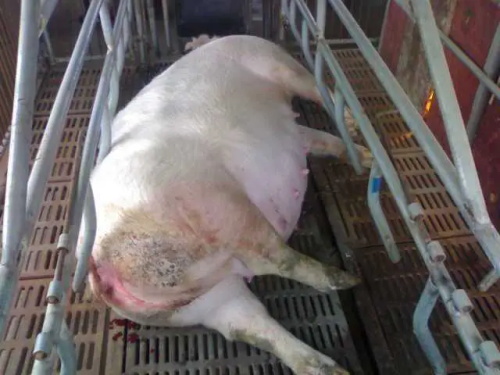In modern swine production, reproductive efficiency is the cornerstone of profitability. Every missed estrus or undetected pregnancy can lead to lost cycles, increased feed costs, and reduced productivity. As a result, precision technologies have become essential tools in breeding programs. Among these technologies, Veterinary ultrasound has proven to be one of the most reliable and non-invasive diagnostic methods to monitor reproductive performance in sows.

Veterinary ultrasound allows farmers and veterinarians to visualize internal reproductive structures in real-time, offering insights that are otherwise impossible to obtain through external observation alone. From identifying the onset of puberty in replacement gilts to accurately tracking pregnancy development, ultrasound is revolutionizing how swine producers manage reproduction. This article explores how ultrasound is used to detect estrus in gilts and monitor the three key stages of pregnancy in sows, highlighting scientific findings and practical applications recognized globally.
Ultrasound for Estrus Detection in Replacement Gilts
One of the earliest and most challenging tasks in swine reproduction is determining when a gilt has entered puberty and is ready to be bred. While some gilts display clear behavioral signs of estrus, such as standing reflexes or mounting behavior, many others show only subtle changes—making accurate detection difficult using traditional methods.
Genetic and physiological studies show that estrus traits in gilts have relatively low heritability: pre-estrus behavior (0.23), standing reflex duration (0.16), the occurrence of standing estrus (0.29), and vulva swelling intensity (0.24). These figures imply that environmental cues and management play a significant role in how gilts express estrus symptoms. Complicating matters further, the traditional back-pressure test performed by humans has only about 48% accuracy, as confirmed by several studies in North America and Europe.
Ultrasound provides a more objective and accurate approach. With B-mode transabdominal ultrasound, practitioners can visualize the ovaries and determine whether follicular development is occurring. During estrus, the ovaries typically contain large, fluid-filled follicles that are easily visible on ultrasound. The presence and size of these follicles help confirm the onset of estrus, even when external signs are weak or absent.
In commercial operations in the United States and Denmark, farms often combine ultrasonic imaging with artificial stimulation—such as boar pheromone sprays or recorded boar vocalizations—to enhance gilt responses. Still, ultrasound remains the gold standard for determining whether a gilt is physiologically ready for insemination.
Furthermore, research has found that gilts with weak or delayed signs of puberty tend to have delayed ovulation even after their first litter. Gilts that fail to show a standing reflex during their first ovulation are also more likely to fail again during subsequent cycles. By accurately diagnosing puberty onset using ultrasound, producers can better select gilts with stronger reproductive potential, thereby improving long-term herd fertility.
Ultrasound Assessment of Sow Pregnancy: Three Stages
Beyond estrus detection, ultrasound plays a crucial role in monitoring the progression of pregnancy in sows. Understanding how pregnancy unfolds can help optimize nutrition, prevent losses due to fetal resorption, and plan for farrowing management. Pregnancy in pigs is typically divided into three stages based on fetal development as seen via ultrasound.
Early Pregnancy Stage (0–45 days)
During early pregnancy, the most critical goal is confirming the presence of conceptuses. Ultrasound examination is usually performed between days 21 and 35 post-breeding, with optimal clarity seen around day 28.
At this stage, the probe is positioned transabdominally over the bladder region to access the uterine horns. The most distinctive ultrasound feature is the presence of fluid-filled gestational sacs—appearing as dark, round or oval shapes. Inside these sacs, small embryos may be seen as slightly brighter echoes surrounded by amniotic fluid.
According to European veterinary studies, early detection reduces the number of open (non-pregnant) sows unknowingly kept in gestation stalls, thus improving space utilization and feeding efficiency. Additionally, early ultrasound can reveal embryonic death or irregular implantation, allowing for timely intervention or rebreeding.
However, early pregnancy diagnosis also requires caution. Sows may display pseudopregnancy, especially if bred but not actually fertilized. In such cases, fluid can accumulate in the uterus, mimicking pregnancy on the ultrasound. Thus, some producers choose to scan again at day 35–40 to confirm the continued presence of live fetuses.
Mid-Pregnancy Stage (45–60 days)
The mid-pregnancy stage is a dynamic period of fetal development, characterized by organogenesis and skeletal calcification. Around day 45, the fetus starts to undergo visible structural changes, including ossification of bones, which appear as bright white reflections on the ultrasound due to increased echogenicity.
The proportion of fetal body mass relative to the amniotic fluid also begins to shift. While early scans show large, fluid-filled sacs, mid-pregnancy scans reveal fetuses occupying more space inside the uterus. The fetal spine, skull, and limbs become more discernible, and heartbeats may be observed with high-resolution probes.
At this stage, veterinarians and farm managers often assess fetal viability and uniformity of development. In countries such as Canada and Germany, mid-pregnancy scans are also used to predict potential birth complications or fetal growth restrictions. An uneven size distribution between fetuses may signal intrauterine crowding or nutritional deficiencies.
Additionally, knowing the number of viable fetuses at this stage helps plan feed adjustments. Sows with larger litters may benefit from increased energy and protein intake to support continued fetal growth.
Late Pregnancy Stage (60 days to term)
The final stage of pregnancy—from day 60 until farrowing (approximately day 114)—is marked by rapid fetal growth and uterine expansion. At this point, bones are fully calcified, and fetuses are significantly larger, occupying most of the uterine space.
Ultrasound scans focus on long-axis views of the fetus, especially the thoracic cavity and spine. These scans offer clear visual confirmation of fetal heartbeats and movement, and they are essential for detecting any anomalies such as deformities or fetal demise.
Since the uterus stretches forward along the abdominal cavity, probe placement must adapt accordingly. The probe should gradually shift cranially (forward) and deeper into the abdomen to keep pace with the uterus’ changing position. Failure to adjust probe placement may lead to missed observations or misdiagnosis.
In countries like the Netherlands and South Korea, real-time late pregnancy scanning has been incorporated into farrowing protocols. By monitoring fetal positioning and development, farms can anticipate farrowing issues, such as stillbirths or prolonged labor, and be better prepared for assisted delivery if necessary.
Benefits of Ultrasound in Swine Reproduction Management
Globally, veterinary ultrasound has become a standard tool in progressive swine production systems. Its benefits extend across several domains:
Non-invasive and Safe
Ultrasound is entirely non-invasive, causing no pain or discomfort to the animal. It can be used repeatedly without risk, making it ideal for monitoring reproductive processes over time.
Accurate and Real-Time
Unlike behavioral observations or hormonal assays, ultrasound provides real-time images of reproductive structures. This accuracy is invaluable for estrus timing, pregnancy diagnosis, and fetal assessment.
Cost-Effective
Although ultrasound equipment represents an initial investment, it often pays for itself through improved breeding success, reduced feed wastage on non-pregnant sows, and better litter outcomes.
Data-Driven Decision Making
By integrating ultrasound results into herd management software, producers can analyze trends, evaluate sow fertility performance, and make informed decisions about culling or rebreeding.
Enhanced Animal Welfare
By reducing the number of unnecessary breedings, preventing false gestation, and ensuring timely intervention in case of fetal issues, ultrasound promotes better health and well-being for both sows and piglets.
Global Adoption and Future Trends
The use of veterinary ultrasound in pigs is expanding globally. In China, ultrasound is now widely used for gilt selection and gestation management. In the United States and Canada, large integrators often train their breeding technicians to perform daily ultrasound checks. In Europe, real-time scanning is frequently combined with automatic sow feeders to create individualized feeding plans based on fetal count.
Future innovations may include 3D ultrasound imaging, AI-driven interpretation software, and integration with wearable biosensors. These technologies will further improve reproductive accuracy, automate data collection, and enhance decision-making.
Conclusion
Veterinary ultrasound has transformed how swine producers detect estrus and manage sow pregnancies. By offering a clear window into the reproductive tract, it enables earlier, more accurate, and more informed decisions throughout the breeding cycle. From assessing gilt readiness to tracking fetal development across three pregnancy stages, ultrasound is no longer just a diagnostic tool—it is a cornerstone of reproductive success.
As global producers continue to prioritize efficiency, animal welfare, and sustainability, veterinary ultrasound will remain at the heart of modern pig farming.
References
Knox, R. V. (2020). Reproductive technology and biotechnology in swine. Animal Frontiers.
Althouse, G. C., & See, M. T. (2018). Swine Reproductive Management. Merck Veterinary Manual.
European Food Safety Authority (EFSA). (2021). Animal welfare and reproductive technologies.
tags:
Text link:https://www.bxlultrasound.com/ns/811.html


